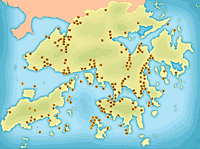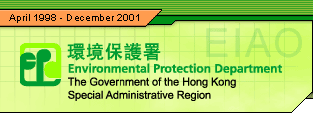|
Content
> Preserving Hong Kong's Natural
Heritage... > Protecting
the Environment for All > Kai
Tak Airport North Apron Decontamination > 1,800
Mega Watt Extension... > West
Rail > International Theme
Park... > Removal of Sediment
in Cheung Sha Wan Fish Culture Zone > Cyberport
Development at Telegraph Bay > Felling
of Five Chimneys at Tsing Yi Power Station > KCR
East Rail Extension > East
Rail Extension
Preserving
Hong Kong's Natural Heritage... A Ensuring a Brighter Future
As efforts
continue to balance the needs of economic development against
the preservation of the environment through the environmental
impact assessment process, many gains often go unnoticed.
A healthy environment is simply taken for granted.
Looking retrospectively
at the more than 190 projects covered by the EIA Ordinance during
the past 3-1/2 years, assessment under the Ordinance has proven
an efficient and effective process. As careful consideration has
been taken to explore and work towards the best possible options
for the environment and for society, much has been achieved that
will benefit present and future generations in Hong Kong.
With Hong Kong's
population becoming more conscious to its environment, the task
of ensuring developmental projects lead to a brighter and cleaner
future has presented challenges and also opportunities for achievement.
Protecting the Environment for All of Hong Kong
 The
scope of projects passing through the EIA process has encompassed
major development projects throughout most of the SAR's 18
districts in Hong Kong Island, Kowloon and the New Territories.
A map outlining the locations of projects assessed so far
under the statutory EIA Ordinance during past 3-1/2 years
is shown in Figure 5A. The
scope of projects passing through the EIA process has encompassed
major development projects throughout most of the SAR's 18
districts in Hong Kong Island, Kowloon and the New Territories.
A map outlining the locations of projects assessed so far
under the statutory EIA Ordinance during past 3-1/2 years
is shown in Figure 5A.
During
the first 3-1/2 years of operation of the EIA Ordinance, a
total of HK$326 billion worth of projects were managed to
meet the environmental criteria set out in the technical memorandum
covering 93km of roads, 75km of railways, 355ha of development
projects and 164ha of decommissioning areas, protecting a
total population of 1,564,450 residents. Through the EIA process,
environmentally friendly transport modes such as railways
have been promoted. The use of natural gas was also encouraged
as fuel for a power station as a means of reducing air pollution.
Conservation of valuable ecological systems was achieved through
compensatory planting or alternative alignment of roads and
railways.
Placement of
noise barriers for residential developments and the evaluation of
options for the best routing for traffic preserved a quieter living
environment for numerous residents. To protect marine environments,
the use of silt curtains and the creation of alternative habitats
for coral have been used. A summary of the key impacts avoided or
designs adopted to protect the environment is shown in Figure 5B:
|
Problems
Avoided or Environmentally Friendly Designs Adopted to Protect
the Environment
- The
100-year old Signal Hill tower is saved by an alignment
change through the East Rail Extension EIA study in Tsim
Sha Tsui
- About
560,000 existing and future residents to be protected by
the West Rail Phase I Special Noise Reduction Design devised
through the EIA Process
- Over
100,000 future residents benefit from the clean up programme
to remove toxic chemicals as recommended in the Kai Tak
Airport North Apron Decomissioning EIA
- Comprehensive
environmental measures incorporated into the Theme Park
Development Project which will create over 20,000 jobs and
attract 20 million visitors per year
- Shifting
from coal to gas as the main fuel for the new HEC Lamma
Power Station to avoid major air pollution
- Environmentally
friendly designs adopted by the Cyberport EIA for 6,000
existing residents and 23,000 future residents
- Electrified
railway system used for West Rail (I) to avoid air pollution
caused by road traffic equivalent to 2,500 bus trips/day.
- Installation
of silt curtain recommended through the Cheung Sha
Wan Fish Culture Zone (FCZ) EIA to protect 22 hectares
of FCZ
- Avoided
adverse impacts to 4 active fishponds of about 2 hectares
- Provided
11km road side noise barriers to protect 120,000 people
- Adopted
buffers ranging from 29 to 67m wide to protect 14 hectares
area for noise attenuation
- Used
podium structures at residential development to segregate
noise sources and receivers to protect 12,000 people
- Avoided
adverse noise impact by adopting 13.5 km viaduct with 7
km noise barriers and 8.4 km rock tunnel, 2.3 km surface
alignment, 3.0 km cut and cover tunnel, and 3.1 km enclosure
structure at grade along West Rail (I)
- Compensated
ecological losses in drainage channel projects by providing
- 6.5
ha grasscrete, 3.0 ha marshcrete, 13.5 ha reinstateds fish
ponds, 12 ha recreated wetland, replanting of 1,500 trees
along 4 km of river channels
- Provided
31,000m2 rubble mound seawall to protect soft
and gorgonian coral growth at Lamma Island during the construction
of power plant
- Provided
silt curtain enclosing the immediate grabbing area to avoid
spillage of mudwater to surrounding water
|
Figure
5B: Key Outcomes of the EIA Ordinance from 1.4.1998 to 31.12.2001
|


